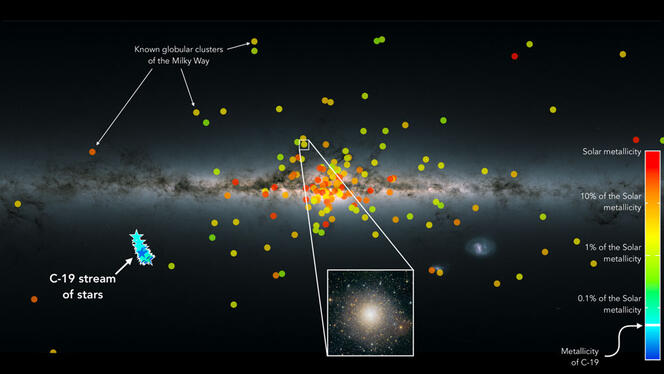You are here
Archaeology goes galactic

“This is the beginning of a new chapter in astronomy,” commented the astronomer François Mignard, scientific director of the Gaia mission for France, on the release of its first catalogue of data in 2016. At the time, the Gaia space observatory had already determined the luminosity, distance and relative speed of around a billion stars with unparallelled precision, while the latest catalogue, published in June 2022, lists a whopping 1.8 billion stars.

All this data will not only provide us with an increasingly detailed map of the Milky Way, but also help us determine why these stars are where they are. “Our Galaxy, as we know it today, first began to form around 13 billion years ago,” says Alejandra Recio-Blanco1, an astronomer at the Côte d'Azur observatory. “With Gaia, we hope to find out what happened throughout the course of its history, and how we got to this point.” Just like its Earth-based counterpart, galactic archaeology’s goal is to go back in time in order to understand the evolution of the Milky Way and paint a picture of what it looked like billions of years ago.
From cosmology to galactic archaeology
Large telescopes such as the W. M. Keck Observatory, Hubble, and more recently the James Webb Space Telescope, which are able to observe very distant galaxies, are giving us a first glimpse of what the Universe looked like shortly after the Big Bang.
The standard cosmological model posits an initially very dense, expanding Universe, in which matter collapsed under the effect of its own gravity, eventually forming stars and galaxies. However, this general picture does not explain how we ended up with spiral galaxies such as our own.
“These models are not sufficiently precise, and thanks in particular to Gaia's discoveries, galactic archaeology has brought complexity to this simplistic image,” Recio-Blanco explains. “From now on, we'll be in a position to study the evolution of one galaxy, our own Milky Way, with a high degree of precision.”



In fact, Gaia has called into question a number of things we thought we understood. “The telescope is so precise that we can measure the motion of stars,” explains Nicolas Martin, at the Strasbourg Astronomical Observatory2. “This enables us to identify groups of stars, known as stellar currents, that are moving in the same direction. After that, it takes a considerable amount of work sifting through data and modelling to find out where these currents come from and thus reconstruct the formation of the Milky Way.”
Unravelling the tangle of stellar currents
The results of this work have shown that, rather than a chaotic period immediately after the Big Bang followed by several billion years of calm, there has in fact been a constant evolution process that has continued until the present day. In other words, the Milky Way is still undergoing subtle transformations as a result of stellar currents. To reconstruct this galactic history, a huge number of stars have to be studied. “You couldn't piece together the history of France by focusing on just a handful of people!” Recio-Blanco says in jest. Gaia has already observed 2% of the stars in our Galaxy, and is revealing events and structures from the past that had until now eluded astronomers, such as the Gaia-Enceladus galaxy, discovered in 2018.



With a mass similar to that of the Small Magellanic Cloud, it merged with the Milky Way about ten billion years ago, transforming the structure and evolution of our Galaxy. “This was a major event in the history of the Milky Way,” Recio-Blanco believes. “Without knowing about it we can’t understand our own Galaxy.” It is now more than ten years since Gaia was placed in orbit, and although our new view of the history of the Galaxy is still sketchy, we can increasingly clearly make out the different stellar currents that coalesced to form the Milky Way as we know it.
Hunting down relic stars
As well as studying stellar motion, galactic archaeologists such as Martin are also hunting down the oldest relic stars, as part of the Pristine project. “We're looking for the oldest stars in our Galaxy. Because they're so rare they are hard to find, but they do have a number of interesting characteristics,” he says.



For the past ten years, Pristine has been using the Canada-France-Hawaii Telescope on Mauna Kea (Hawaii, US) to track down these objects. The telescope is equipped with a special filter that enables it to measure the metallicity (the abundance of elements heavier than hydrogen and helium) of the stars observed, a key factor in determining their age. “Shortly after the Big Bang, there were no atoms heavier than helium in the Universe. All the other elements came later, produced in the cores of the first stars and then scattered into space when these celestial bodies exploded,” Martin explains. “This means that the composition of a star that emerged more recently will be slightly richer in metals than an older one, which enables us to roughly define their age.”
In the ten years the Pristine programme has been running, millions of stars have been observed, several hundred of which have such low metallicity that they apparently formed during the first two billion years of the Universe, making them exceptional relics.
The goal is to compare these findings with Gaia data in order to reconstruct their paths and discover how these early clusters ended up capturing other stellar currents. “These fossil stars are a window into the distant past,” Martin adds. “We are beginning to sketch out the early history of the Milky Way, even if we still have a long way to go.”
Ongoing collision
Reconstructing the entire past of our Galaxy, from the earliest stars to its present-day structure, is still a far cry despite the impressive progress made since the launch of Gaia. “What we now know is that the Milky Way is not cut off from its surroundings,” Recio-Blanco says. “We are constantly affected by our environment, even on a galactic scale.”

The most recent illustration of this was the discovery that the galactic disc ripples up and down slightly, rather like a pond into which a pebble has been thrown. This oscillation, revealed by Gaia material, is thought to be due to the passage of the Sagittarius Dwarf Spheroidal Galaxy through the Milky Way, into which it is gradually falling. This satellite galaxy, 10,000 light-years wide and discovered barely thirty years ago, disturbs the galactic disc each time it passes through it, triggering waves of star formation. In any case, Gaia's work is by no means over, and the latest data catalogue published in October 2023 covers only the first 34 months of the mission. Galactic archaeologists still have years of star observations to analyse, and of one thing they can be sure: the Milky Way is far from having given up all the secrets of its tumultuous history. ♦
Further reading on our website
Gaia: le catalogue galactique est arrivé (Gaia: the new galactic catalogue now available). In French.
Les plus vieilles galaxies jamais confirmées (The oldest galaxies ever discovered). In French.














